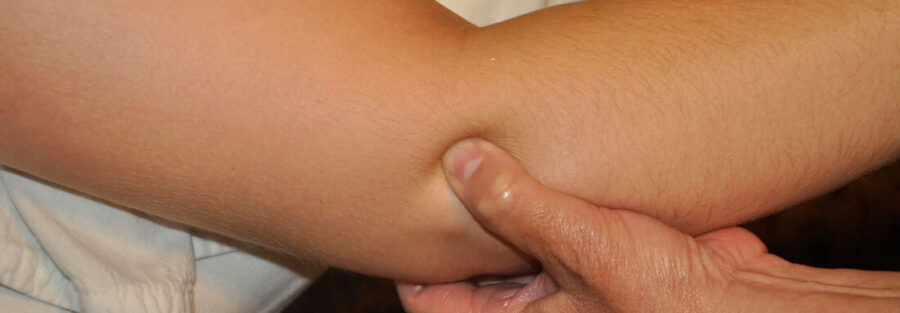There is much more to elbow pain than meets the eye, but it is very treatable. Unfortunately, misdiagnosis and improper self-treatment is very common.
[blockquote type=”1″ position=”right” author=””]Many people self-diagnose elbow and forearm pain and rely on a conventional “band aid” approach. They end up frustrated.[/blockquote]
Even wrist pain, which many erroneously self-diagnose as “carpal tunnel” often originates in the muscles of the forearm, as trigger points. Here is a short breakdown of 3 VERY common types of elbow, forearm and wrist pain: (This is not a comprehensive list and does not include joint dysfunction, arthritis, bursitis, nerve conduction problems, etc. which are less common)
1. Tennis elbow. This is pain on the lateral aspect (outside) of the elbow. It is caused by repeated twisting, rotation, and extension (the movements you would use during backhand tennis swing) Some occupational repetitive movements can also cause “tennis elbow.” I have seen athletes, drummers, construction workers, and even people that spend hours sewing, gardening, or knitting present with this type of pain.
2. Golfers elbow manifests as pain on the INSIDE (medial aspect) of the elbow. It has similar causes, but the movements that trigger this kind of pain involve flexion, more like pulling objects closer to yourself such as performing a cable row in the gym or a bicep curl, or executing a golf swing. This type of pain, as with “tennis” elbow, can also be caused by what we do on a daily, repetitive basis.
3. Other types of forearm pain caused by trigger points or nerve impingement. This kind of pain tends to refer to places other than where the pain originally started. Irritated or inflamed muscles can also impinge on surrounding nerves causing pain.
How conventional medicine treats it
Elbow, forearm, and wrist pain is usually treated by using braces, ice, and NSAID’s such as ibuprofen, and rest. In some cases, these therapies can be useful (in particular, rest) but they only treat symptoms, and can often make the problem worse in the long run. In some cases, cortisone shots are administered, which also tend to produce very little results for many people or even aggravate the condition.
How functional acupuncture treats it
First, we are diagnosing pain in general, using our own terminology, which can range from “qi and blood stagnation” to “heat” to “cold bi” syndrome. Qi and blood stagnation is about damaged tissue. It is associated with trauma in western medicine. The goal is to “move qi and blood”.
Why? We want to get blood moving because everything needed for healing is carried in the blood. Instead of creating further “stagnation” or “congestion” with ice, too much compression/limited ROM from traditional braces, slings, and NSAID overuse, we are trying to encourage the body to heal itself and keep tissue healthy and strong. We do not want to hinder this process by simply suppressing symptoms.
Our diagnosis could also (somewhat) correlate with inflammation, (heat) degenerative changes (Liver yin deficiency) or arthritic pain aggravated by cold (cold bi syndrome) We will almost always perform an assessment and examination (strength, range of motion, palpation, etc.) to determine where the pain is originating.

A thorough intake process can give us further clues, such as what aggravates a condition from a more internal perspective, such as stress, exhaustion, diet, environmental factors, and mental outlook. This is one of the reasons an acupuncturist may needle points nowhere near your elbow, such as your lower leg. We are treating both locally and systemically, to provide the best conditions for healing.
One of my favorite patients was a drummer, and by palpation and repeating the movements that reproduced pain, I could tell what might have changed in his playing style. (I’m a drummer too, so I can get pretty nerdy about anatomy and drumming) But we also found out that the pain was worse when he was feeling stressed or tired.
Some practitioners, also look at Trigger Points, a theory that is often used in a western (usually physical therapy) setting. For example, if you have trigger points in a muscle called the brachioradialis or extensor muscles of the forearm, you might very well have pain in the elbow or maybe at a more distally located point (further down the arm towards the wrist.)
If you have wrist pain, the problem might be occurring in a trigger point further up the arm (more proximally) and eliminating those trigger points via acupuncture combined with certain types of myofascial release techniques can often solve long-standing and frustrating pain that is not responsive to traditional techniques.
It is also important to address the movements that are causing the pain in the first place. I might advise a tennis player to try a better racquet or take a few lessons to improve technique. Skiers can exacerbate elbow pain by how they plant a pole. I might suggest to a drummer making adjustments to the arrangement of their kit.
Occupational movements might be a bit more difficult to manage, but often even small changes can be made such as taking more breaks or making small adjustments in ergonomics. Awareness and communication with supervisors is key. In the gym, I advise modifications for certain exercises.










































